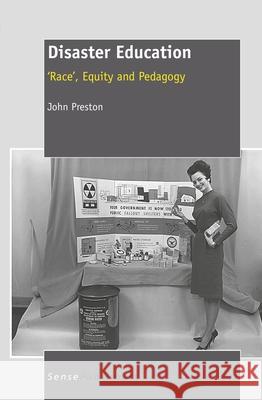Disaster Education : 'Race', Equity and Pedagogy » książka
Disaster Education : 'Race', Equity and Pedagogy
ISBN-13: 9789460918711 / Angielski / Miękka / 2012 / 128 str.
Disaster Education : 'Race', Equity and Pedagogy
ISBN-13: 9789460918711 / Angielski / Miękka / 2012 / 128 str.
(netto: 178,07 VAT: 5%)
Najniższa cena z 30 dni: 179,73
ok. 30 dni roboczych.
Darmowa dostawa!
From 'Duck and Cover' in the 1950s, when American schoolchildren were instructed to hide beneath their desks in the event of nuclear attack to contemporary campaigns against pandemic flu, education campaigns have been used to prepare the general public for apocalyptic events. Governments have made use of various media from films, leaflets and television to the internet to inform, inspire and scare populations. Forms of disaster education also permeate popular culture with films and television programmes illustrating survival techniques from dealing with terrorist attacks in '24' to thwarting zombie apocalypse in 'The Walking Dead' and '28 Days Later' . Using critical race theory and whiteness studies the book argues that information about disasters has always, tacitly or overtly, prioritised the survival of certain groups of citizens above others. Drawing on examples from the UK and the US, from past and contemporary disaster education and popular culture, it considers that rather than being kitsch, naive and ephemeral, such campaigns are central to the way in which states define survival, life and death. The book will be of interest to educationalists, historians, sociologists and cultural theorists as well as those working in emergency planning, public health and communications."
From Duck and Cover in the 1950s, when American schoolchildren were instructed to hide beneath their desks in the event of nuclear attack to contemporary campaigns against pandemic flu, education campaigns have been used to prepare the general public for apocalyptic events. Governments have made use of various media from films, leaflets and television to the internet to inform, inspire and scare populations. Forms of disaster education also permeate popular culture with films and television programmes illustrating survival techniques from dealing with terrorist attacks in 24 to thwarting zombie apocalypse in The Walking Dead and 28 Days Later .Using critical race theory and whiteness studies the book argues that information about disasters has always, tacitly or overtly, prioritised the survival of certain groups of citizens above others. Drawing on examples from the UK and the US, from past and contemporary disaster education and popular culture, it considers that rather than being kitsch, naive and ephemeral, such campaigns are central to the way in which states define survival, life and death. The book will be of interest to educationalists, historians, sociologists and cultural theorists as well as those working in emergency planning, public health and communications.











